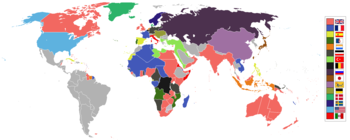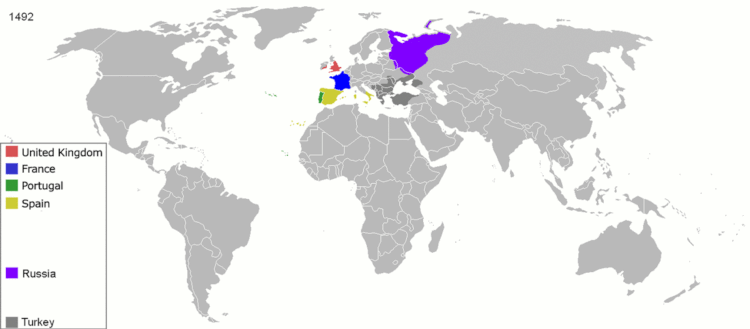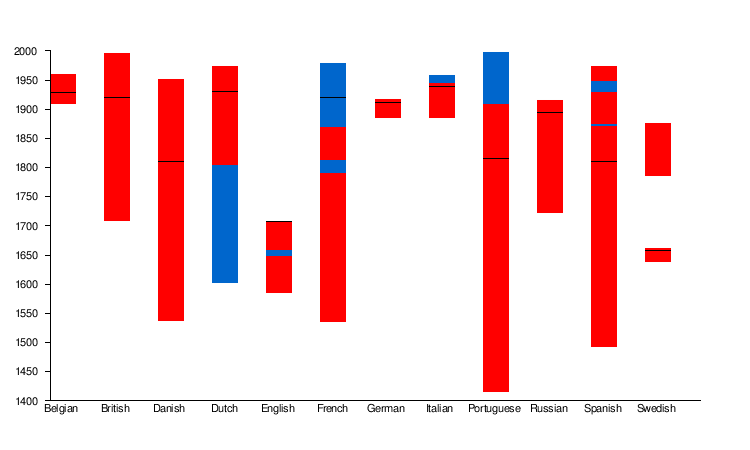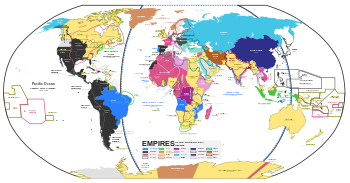A colonial empire is a collective of territories (often called colonies), either contiguous with the imperial center or located overseas, settled by the population of a certain state and governed by that state.

Before the expansion of early modern European powers, other empires had conquered and colonized territories, such as the Roman Empire in Europe, North Africa and Western Asia. Modern colonial empires first emerged with a race of exploration between the then most advanced European maritime powers, Portugal and Spain, during the 15th century.[1] The initial impulse behind these dispersed maritime empires and those that followed was trade, driven by the new ideas and the capitalism that grew out of the European Renaissance. Agreements were also made to divide the world up between them in 1479, 1493, and 1494. European imperialism was born out of competition between European Christians and Ottoman Muslims, the latter of which rose up quickly in the 14th century and forced the Spanish and Portuguese to seek new trade routes to India, and to a lesser extent, China.
Although colonies existed in classical antiquity, especially amongst the Phoenicians and the ancient Greeks who settled many islands and coasts of the Mediterranean Sea, these colonies were politically independent from the city-states they originated from, and thus did not constitute a colonial empire.[2] This paradigm shifted by the time of the Ptolemaic Empire, the Seleucid Empire, and the Roman Empire.
The European countries of the modern era that are most remembered as colonial empires are the United Kingdom, Spain, Portugal, Italy, Netherlands, France, Germany and Belgium.[3][4]
History
European colonial empires
Portugal began establishing the first global trade network and one of the first colonial empires[5][6] under the leadership of Henry the Navigator. The empire spread throughout a vast number of territories distributed across the globe (especially at one time in the 16th century) that are now parts of 60 different sovereign states. Portugal would eventually control Brazil, territories such as what is now Uruguay and some fishing ports in north, in the Americas; Angola, Mozambique, Portuguese Guinea, and São Tomé and Príncipe (among other territories and bases) in the North and the Subsaharan Africa; cities, forts or territories in all the Asian subcontinents, as Muscat, Ormus and Bahrain (amongst other bases) in the Persian Gulf; Goa, Bombay and Daman and Diu (amongst other coastal cities) in India; Portuguese Ceylon; Malacca, bases in Southeast Asia and Oceania, as Makassar, Solor, Banda, Ambon and others in the Moluccas, Portuguese Timor; and the granted entrepôt-base of Macau and the entrepôt-enclave of Dejima (Nagasaki) in East Asia, amongst other smaller or short-lived possessions.

During its Siglo de Oro, the Spanish Empire had possession of Mexico, South America, the Philippines, all of southern Italy, a stretch of territories from the Duchy of Milan to the Netherlands, Luxembourg, and Belgium, parts of Burgundy, and many colonial settlements in the Americas, Africa, and Asia. Possessions in Europe, Africa, the Atlantic Ocean, the Americas, the Pacific Ocean, and East Asia qualified the Spanish Empire as attaining a global presence. From 1580 to 1640 the Portuguese Empire and the Spanish Empire were conjoined in a personal union of its Habsburg monarchs during the period of the Iberian Union, but beneath the highest level of government, their separate administrations were maintained.
Subsequent colonial empires included the French, English, Dutch and Japanese empires. By the mid-17th century, the Tsardom of Russia, continued later as the Russian Empire, the Soviet Union, and modern Russia, became the largest contiguous state in the world and remains so to this day.
Throughout the 19th and early 20th century, by virtue of its technological and maritime supremacy, the British Empire steadily expanded to become by far the largest empire in history; at its height ruling over a quarter of the Earth's land area and 24% of the population. Britain's role as a global hegemon during this time ushered in a century of "British Peace", lasting from the end of the French Revolutionary and Napoleonic Wars to the start of World War I. During the New Imperialism, Italy and Germany also built their colonial empires in Africa.
Timeline
The chart below[original research?] shows the span of some European colonial empires.
- Black lines mark the year of the empires largest territorial extent of land area.
- Red represents that the empire is at that time a monarchy.
- Blue represents that the empire is at that time a republic.

List of colonial empires

 Belgian Empire (1908–1962)
Belgian Empire (1908–1962)- Possessions in Africa
 Belgian Congo (1908–1960)
Belgian Congo (1908–1960) Ruanda-Urundi (1922–1962)
Ruanda-Urundi (1922–1962)
- Possessions in Asia
 Belgian concession of Tianjin (1902–1931)
Belgian concession of Tianjin (1902–1931)
- Possessions in Africa
 British Empire (1707–1997/present)
British Empire (1707–1997/present)- Evolution of the British Empire; Angevin Empire;
 English colonial empire (1585–1707)
English colonial empire (1585–1707) - Possessions in Europe
- Possessions in Africa
 British Somaliland (1884–1960)
British Somaliland (1884–1960) British Egypt (1914–1936)
British Egypt (1914–1936) Anglo-Egyptian Sudan (1899–1956)
Anglo-Egyptian Sudan (1899–1956) East Africa Protectorate (1895–1920)
East Africa Protectorate (1895–1920) Kenya Colony (1920–1963)
Kenya Colony (1920–1963) Uganda Protectorate (1894–1962)
Uganda Protectorate (1894–1962) Tanganyika (territory) (1922–1961)
Tanganyika (territory) (1922–1961) Protectorate of Nyasaland (1893–1964)
Protectorate of Nyasaland (1893–1964) Protectorate of Northern Rhodesia (1924–1964)
Protectorate of Northern Rhodesia (1924–1964) Colony of Southern Rhodesia (1923–1965), (1979–1980)
Colony of Southern Rhodesia (1923–1965), (1979–1980) Bechuanaland Protectorate (1885–1966)
Bechuanaland Protectorate (1885–1966) British Nigeria (1914–1954)
British Nigeria (1914–1954) British Gold Coast (1867–1957)
British Gold Coast (1867–1957) British Sierra Leone (1808–1961)
British Sierra Leone (1808–1961) British Gambia (1821–1965)
British Gambia (1821–1965)
- Possessions in the Americas
 Thirteen Colonies
Thirteen Colonies British West Indies
British West Indies Bahamas
Bahamas Barbados
Barbados Bermuda
Bermuda Leeward Islands (1671–1816),(1833–1958)
Leeward Islands (1671–1816),(1833–1958) Windward Islands (1833–1960)
Windward Islands (1833–1960) Cayman Islands
Cayman Islands Colony of Jamaica (1655–1962)
Colony of Jamaica (1655–1962) Trinidad and Tobago
Trinidad and Tobago Turks and Caicos Islands
Turks and Caicos Islands
 British Honduras (1862–1981)
British Honduras (1862–1981) British Guiana (1814–1966)
British Guiana (1814–1966) Kingdom of Mosquitia (1638–1860)
Kingdom of Mosquitia (1638–1860)
- Possessions in South Asia
- Possessions in East Asia
 British Hong Kong (1841–1997)
British Hong Kong (1841–1997)
- Possessions in the Middle East
 Trucial States (1820–1971)
Trucial States (1820–1971) British Bahrain (1861-1971)
British Bahrain (1861-1971) British Qatar (1916–1971)
British Qatar (1916–1971) British Iraq (1920–1932) (1932–1958)
British Iraq (1920–1932) (1932–1958) Emirate of Transjordan (1921–1946)
Emirate of Transjordan (1921–1946) Mandatory Palestine (1920–1948)
Mandatory Palestine (1920–1948) Sheikhdom of Kuwait (1899–1961)
Sheikhdom of Kuwait (1899–1961) Aden Protectorate (1872–1963)
Aden Protectorate (1872–1963) Muscat and Oman (1892–1970)
Muscat and Oman (1892–1970) Emirate of Afghanistan (protectorate) (1879–1947)
Emirate of Afghanistan (protectorate) (1879–1947)
- Possessions in Southeast Asia
- Dominions of the United Kingdom
 Canada
Canada Dominion of Newfoundland
Dominion of Newfoundland States and territories of Australia (1901–present)
States and territories of Australia (1901–present)- Australia itself a colony that gradually increased its independence in 1901, 1942 and 1986, was tasked with the government of multiple other British colonies and territories and the mandates of New Guinea and Nauru
 Realm of New Zealand (1907–present)
Realm of New Zealand (1907–present)- New Zealand itself a colony that gradually increased its independence in 1907, 1947 and 1986, was tasked with the government of multiple other British colonies and territories and the mandate of Samoa. It was also nominal co-trustee of the mandate of Nauru. The remaining non-self-governing New Zealand territory is Tokelau.
 Mandates under South African administration (1915–1990)
Mandates under South African administration (1915–1990)- The South-West Africa mandate was governed by the Union of South Africa, that itself a colony that gradually increased its independence in 1910, 1931 and 1961.
- Evolution of the British Empire; Angevin Empire;
 Danish Empire (1620–1979/present)
Danish Empire (1620–1979/present) Danish India (1620–1869)
Danish India (1620–1869) Danish Gold Coast (1658–1850)
Danish Gold Coast (1658–1850)- Danish colonization of the Americas:
 Danish West Indies (1754–1917)
Danish West Indies (1754–1917) Greenland (1814–1979)
Greenland (1814–1979)
 Dutch Empire (1602–1975/present)
Dutch Empire (1602–1975/present)- Dutch colonization of the Americas by
 Dutch West India Company:
Dutch West India Company:  Dutch East India Company
Dutch East India Company Dutch India
Dutch India Dutch East Indies
Dutch East Indies Dutch Cape Colony (1652–1806)
Dutch Cape Colony (1652–1806) Dutch Formosa (1624–1662)
Dutch Formosa (1624–1662) Dutch Ceylon (1640-1796)
Dutch Ceylon (1640-1796) Dutch Malacca (1641-1795) (1818-1825)
Dutch Malacca (1641-1795) (1818-1825) Dejima (1641–1854)
Dejima (1641–1854) Dutch Mauritius (1638–1710)
Dutch Mauritius (1638–1710)
- Dutch colonization of the Americas by
 French Empire (1534–1980/present)
French Empire (1534–1980/present)- French colonization of the Americas:
- France Antarctique (1555–1567)
 New France (1534–1763) and Quebec
New France (1534–1763) and Quebec French Louisiana
French Louisiana French West Indies (1635–today)
French West Indies (1635–today)- Îles des Saintes (1648–present)
- Marie-Galante (1635–present)
- la Désirade (1635–present)
- Guadeloupe (1635–present)
- Martinique (1635–present)
- French Guiana
 Saint Pierre and Miquelon
Saint Pierre and Miquelon
- Asia:
- French India (1664–1962)
 French Indochina and French Indochinese Union (1887–1954)
French Indochina and French Indochinese Union (1887–1954)- Laos (protectorate) (1893–1953)
- Cambodia (protectorate) (1863–1953)
- Vietnam
- Cochinchina (Southern Vietnam) (1858–1949)
- Annam (protectorate) (Central Vietnam) (1883–1949)
- Tonkin (protectorate) (Northern Vietnam) (1884–1949)
- China
- The foreign concessions : French Concession of Shanghai (1849–1946), Tianjin (1860–1946) and Hankou (1898–1946)
- The spheres of French influence officially recognized by China on the provinces of Yunnan, Guangxi, Hainan, and Guangdong
- Shamian Island (1859–1949) (a fifth of the island)
 French Guangzhouwan (1898–1945)
French Guangzhouwan (1898–1945)
- Possessions in the Middle East
- Mandate for Syria and Lebanon (1920–1946)
- French Africa:
- French North Africa (1830–1934) and French Algeria
- French Morocco (1912–1956)
- French Tunisia (1886–1956)
- French Somaliland (1883–1975)
- French West Africa (1895–1958)
- French Madagascar (1897–1958)
- French Comoros (1866–1968)
- French Equatorial Africa (1910–1958)
- Isle de France (1715–1810)
- Seychelles (1756–1810)
- The Scattered Islands
- Reunion island (1710–present)
- Mayotte (1841–present)
- Oceania:
 New Hebrides (1906–1980)
New Hebrides (1906–1980) French Polynesia
French Polynesia New Caledonia
New Caledonia Wallis and Futuna
Wallis and Futuna- Clipperton island
- French colonization of the Americas:
 German Empire (1884–1920)
German Empire (1884–1920) Kamerun (1884–1918)
Kamerun (1884–1918) Togoland (1884–1916)
Togoland (1884–1916) German South West Africa (1884–1919)
German South West Africa (1884–1919) German New Guinea (1884–1919)
German New Guinea (1884–1919) German East Africa (1885–1919)
German East Africa (1885–1919) German Samoa (1900–1920)
German Samoa (1900–1920)- German Concession in Tientsin
- German concession of Hankou
- German Tsingtao
 Italian Empire (1882–1960)
Italian Empire (1882–1960) Eritrea (1882–1947)
Eritrea (1882–1947) Somaliland (1889–1947, 1950–1960 as Italian Trust Territory of Somaliland)
Somaliland (1889–1947, 1950–1960 as Italian Trust Territory of Somaliland) Ethiopia (1936–1941)
Ethiopia (1936–1941) Italian East Africa (formed by merging Eritrea, Somaliland and Ethiopia: 1936–1947)
Italian East Africa (formed by merging Eritrea, Somaliland and Ethiopia: 1936–1947)
 Cyrenaica (1912–1947)
Cyrenaica (1912–1947) Tripolitania (1912–1947)
Tripolitania (1912–1947) Libya (Formed by merging Cyrenaica and Tripolitania in 1934. It dissolved in 1947. It also included the Southern Military Territory of Fezzan)
Libya (Formed by merging Cyrenaica and Tripolitania in 1934. It dissolved in 1947. It also included the Southern Military Territory of Fezzan)
 Italian Islands of the Aegean (1912–1947)
Italian Islands of the Aegean (1912–1947) Italian Albania (1939–1943)
Italian Albania (1939–1943)- Italian France (1940–1943)
 Italian Montenegro (1941–1943)
Italian Montenegro (1941–1943)- Italian concession of Tientsin (1901–1947)
 Ottoman Empire (1354–1908)
Ottoman Empire (1354–1908)
- Europe:
 Cretan State (1898–1913)
Cretan State (1898–1913) Crimean Khanate (1475–1774)
Crimean Khanate (1475–1774) Ottoman Albania (1479–1912)
Ottoman Albania (1479–1912) Ottoman Bosnia and Herzegovina (1463–1908)
Ottoman Bosnia and Herzegovina (1463–1908) Ottoman Bulgaria (1396–1878)
Ottoman Bulgaria (1396–1878) Ottoman Crete (1667–1898)
Ottoman Crete (1667–1898) Ottoman Cyprus (1571–1878)
Ottoman Cyprus (1571–1878) Ottoman Greece (1453–1830)
Ottoman Greece (1453–1830) Ottoman Hungary (1541–1699)
Ottoman Hungary (1541–1699) Ottoman Serbia (1459–1804)
Ottoman Serbia (1459–1804) Rumelia Eyalet (1365–1867)
Rumelia Eyalet (1365–1867) Sanjak of Rhodes (1522–1912)
Sanjak of Rhodes (1522–1912) United Principalities of Moldavia and Wallachia (1859–1862)
United Principalities of Moldavia and Wallachia (1859–1862)
- Asia:
 Protectorate of Aceh (1496–1903)
Protectorate of Aceh (1496–1903) Ottoman Arabia (1517–1919)
Ottoman Arabia (1517–1919) Ottoman Iraq (1538–1918)
Ottoman Iraq (1538–1918) Ottoman Syria (1517–1918)
Ottoman Syria (1517–1918) Emirate of Nejd (1818-1914)
Emirate of Nejd (1818-1914)
- Africa:
 Khedivate of Egypt (1867–1914)
Khedivate of Egypt (1867–1914) Turco-Egyptian Sudan (1820–1885)
Turco-Egyptian Sudan (1820–1885) Ottoman Egypt (1517–1914)
Ottoman Egypt (1517–1914) Ottoman Absinia (1554–1872)
Ottoman Absinia (1554–1872) Ottoman Algeria (1516–1830)
Ottoman Algeria (1516–1830) Ottoman Tripolitania (1551–1912)
Ottoman Tripolitania (1551–1912) Ottoman Tunisia (1574–1881)
Ottoman Tunisia (1574–1881)
- Europe:
 Portuguese Empire (1415–1999)
Portuguese Empire (1415–1999)- Evolution of the Portuguese Empire
 Portuguese colonization of the Americas
Portuguese colonization of the Americas Colonial Brazil (1500–1815)
Colonial Brazil (1500–1815)
 Portuguese India (1505–1961)
Portuguese India (1505–1961) Portuguese Ceylon (1598–1658)
Portuguese Ceylon (1598–1658) Portuguese Timor (1702–1975)
Portuguese Timor (1702–1975) Portuguese Macau (1557–1999)
Portuguese Macau (1557–1999)- Portuguese Malacca (1511–1641)
- Portuguese Nagasaki (1580–1587)
- Portuguese Oman (1507–1656)
- Tamão (1514–1521)
- Portuguese Africa
 Portuguese East Africa (1498–1975)
Portuguese East Africa (1498–1975) Portuguese West Africa (1575–1975)
Portuguese West Africa (1575–1975) Portuguese Guinea (1474–1974) (1974–1975)
Portuguese Guinea (1474–1974) (1974–1975) Portuguese Cape Verde (1462–1975)
Portuguese Cape Verde (1462–1975) Portuguese São Tomé and Príncipe (1470–1975)
Portuguese São Tomé and Príncipe (1470–1975)- Fort of São João Baptista de Ajudá (1721–1961)
- Portuguese Gold Coast (1482–1642)
 Russian Empire (1721–1917)
Russian Empire (1721–1917) Spanish Empire (1492–1825/1898-1975)
Spanish Empire (1492–1825/1898-1975)- Spanish colonization of the Americas
 Spanish East Indies (1565–1898)[7]
Spanish East Indies (1565–1898)[7] Spanish Africa
Spanish Africa Spanish Guinea (1778–1968)[8]
Spanish Guinea (1778–1968)[8] Spanish Sahara (1884–1975)
Spanish Sahara (1884–1975) Spanish protectorate in Morocco (1912–1956)
Spanish protectorate in Morocco (1912–1956) Ifni (1476–1524/1859–1969).
Ifni (1476–1524/1859–1969).
- Possessions of the Catholic Monarchs of Spain and of
 Habsburg Spain in Europe:
Habsburg Spain in Europe:- Kingdom of Naples (1503-1700)
- Kingdom of Sicily (1479-1700)
- Kingdom of Sardinia (1479-1700)

 Duchy of Milan (1559–1706)[9]
Duchy of Milan (1559–1706)[9] Spanish Netherlands (1556–1713)
Spanish Netherlands (1556–1713)
 Swedish Empire (1638–1663, 1733, 1784–1878)
Swedish Empire (1638–1663, 1733, 1784–1878)- Swedish colonies in the Americas
 New Sweden (1638–1655)
New Sweden (1638–1655) Swedish colony of Saint Barthélemy (1784–1878)
Swedish colony of Saint Barthélemy (1784–1878) Guadeloupe (1813–1814)
Guadeloupe (1813–1814)
 Swedish Gold Coast (1650–1658, 1660–1663)
Swedish Gold Coast (1650–1658, 1660–1663) Swedish Africa Company
Swedish Africa Company Swedish East India Company
Swedish East India Company Parangipettai (1733)
Parangipettai (1733) Swedish Factory, Canton Factories (1757–1860)
Swedish Factory, Canton Factories (1757–1860)
- Swedish colonies in the Americas
 Japanese Empire (1868–1945)
Japanese Empire (1868–1945) Ezo as Hokkaido (1869–present)
Ezo as Hokkaido (1869–present) Ryukyu as Okinawa Prefecture (1879–1945 & 1972–present)[10]
Ryukyu as Okinawa Prefecture (1879–1945 & 1972–present)[10] Taiwan (1895–1945)
Taiwan (1895–1945) Karafuto Prefecture (1905–1949)
Karafuto Prefecture (1905–1949) Korea (1910–1945)
Korea (1910–1945) South Seas Mandate (1919–1947)
South Seas Mandate (1919–1947) Manchukuo (1932–1945)
Manchukuo (1932–1945) Greater East Asia Co-Prosperity Sphere (1932–1945)
Greater East Asia Co-Prosperity Sphere (1932–1945)
Other countries with informal colonial possessions:
 United States (1816–present)
United States (1816–present)- United States overseas territorial acquisitions
 American Samoa (1899–Present)
American Samoa (1899–Present) Guam (1898–Present)
Guam (1898–Present) Northern Mariana Islands (1986–Present)
Northern Mariana Islands (1986–Present) Puerto Rico (1898–Present)
Puerto Rico (1898–Present) United States Virgin Islands (1917–Present)
United States Virgin Islands (1917–Present) Commonwealth of the Philippines (1935–1946)
Commonwealth of the Philippines (1935–1946) Insular Government of the Philippine Islands (1902–1935)
Insular Government of the Philippine Islands (1902–1935) Republic of Hawaii (1898–1900)
Republic of Hawaii (1898–1900) Minor Outlying Islands (1857–Present)
Minor Outlying Islands (1857–Present)- Guano Islands Act Claims (1856–Present)
- Canton and Enderbury Islands (1939–1979)
 Ryukyu Islands (1950–1972)
Ryukyu Islands (1950–1972) Trust Territory of the Pacific Islands (1947–1994)
Trust Territory of the Pacific Islands (1947–1994)
- American Colonization Society (1816–1847)
- Colony of Liberia (1821–1847)
- Kentucky in Africa (1828–1847)
- Maryland-in-Africa (1834–1857)[11]
- Mississippi-in-Africa (1835–1842)
- Colony of Liberia (1821–1847)
- American Concessions
 American Concession in Shanghai (1848–1863)
American Concession in Shanghai (1848–1863)- American concession in Tianjin (1869–1902)
- American Trading Company of Borneo (1865–1881)
- Corn Islands (1914–1971)
 Guantanamo Bay (1903–present)
Guantanamo Bay (1903–present) Panama Canal Zone (1903–1979)
Panama Canal Zone (1903–1979)- Pituffik Space Base (1943–present)
- United States overseas territorial acquisitions
 Habsburg monarchy Colonies[12] and the
Habsburg monarchy Colonies[12] and the  Austro-Hungarian Empire (1719–1750, 1778–1783, 1901–1917)
Austro-Hungarian Empire (1719–1750, 1778–1783, 1901–1917)- Austrian colonial policy
- Franz Josef Land
- Austro-Hungarian concession of Tianjin (1901–1917)
- Hungarian colonial attempts[13][14]
 Polish–Lithuanian Commonwealth (1637–1795) and
Polish–Lithuanian Commonwealth (1637–1795) and  Poland colonial initiatives
Poland colonial initiatives Duchy of Courland and Semigallia (a Latvian vassal of Poland–Lithuania in 1637–1690):
Duchy of Courland and Semigallia (a Latvian vassal of Poland–Lithuania in 1637–1690):- Jaxa (1665–1685)
- Toco (1688–1689)
- Colonization attempts by Poland
- Polish occupation zone in Germany
 German colonial initiatives (1683–1721)
German colonial initiatives (1683–1721)- Colonies of
 Brandenburg-Prussia (1683–1721)[12]
Brandenburg-Prussia (1683–1721)[12] - Colonies of
 County of Hanau[15]
County of Hanau[15] - Neu-Askania (1828–1856)
- German colonization of the Americas
- Klein-Venedig (1528–1546)
- Colonies of
- Italy and the colonization of the Americas
 Grand Duchy of Tuscany: Thornton expedition (1608–1609)
Grand Duchy of Tuscany: Thornton expedition (1608–1609) Kingdom of Sicily: Kingdom of Africa (1135–1160)
Kingdom of Sicily: Kingdom of Africa (1135–1160) Knights Hospitaller (Malta, a vassal of the
Knights Hospitaller (Malta, a vassal of the  Kingdom of Sicily): Hospitaller colonization of the Americas
Kingdom of Sicily): Hospitaller colonization of the Americas
 Norway
Norway- List of possessions of Norway (1920–present)
- Erik the Red's Land
- Norway Antarctic and sub-Antarctic possessions (1927–1957)[16]
 Kingdom of Scotland (1621–1707)
Kingdom of Scotland (1621–1707) Kingdom of Morocco (1975–present)
Kingdom of Morocco (1975–present) Omani Empire (1652–1892)
Omani Empire (1652–1892)- Yaruba dynasty (1624–1742)
 Sultanate of Muscat (1652–1820)
Sultanate of Muscat (1652–1820) Sultanate of Zanzibar (taken by Oman in 1698, became capital of the Omani Sultanate or Empire from 1632 or 1640; until 1890)
Sultanate of Zanzibar (taken by Oman in 1698, became capital of the Omani Sultanate or Empire from 1632 or 1640; until 1890)- Mombasa (1698–1728, 1729–1744, 1837–1890)
- Gwadar (1783–1958)
- Chinese Empire (from Qin dynasty to
 Qing dynasty),
Qing dynasty),  (221 BC – 1911)
(221 BC – 1911)- Imperial Chinese Tributary System
- Guangxi
- Hainan (since the Han dynasty)
- Manchuria (during the Tang, Liao, Jin, Yuan, Ming, and Qing dynasties)
- Korea
- Canghai Commandery(A commandery that self subjugated to Han dynasty from Dongye)
- Four Commanderies of Han (Established after the fall of Gojoseon)
- Daifang Commandery (Offshoot of the former four commanderies of Han that existed in the 3rd to 4th century)
- Colonization attempts of the Tang dynasty after Unification of the three kingdoms of Korea (Gyerim Territory Area Command, Protectorate General to Pacify the East and Ungjin Commandery)
- Dongnyeong Prefectures, Ssangseong Prefectures and Tamna prefectures (Yuan dynasty)
- Inner Mongolia
- Outer Mongolia (during for example the Tang and Qing dynasties)
- Taiwan (during the Qing dynasty)
- Tibet (during the Yuan and Qing dynasties)
- Yunnan
- Vietnam (from the Han to Tang dynasties, and during the early Ming dynasty)
- Xinjiang
- Central Asia (during the Tang and Qing dynasties)
 Ethiopian colonies as the Aksum Empire
Ethiopian colonies as the Aksum Empire- Viceroyalty of Yemen (520–578)
 Persian Empires
Persian Empires- Aghlabids colonies as Arab vassals of
 Abbasid Caliphate in Ifriqiya
Abbasid Caliphate in Ifriqiya  Chola empire
Chola empire Sikh Empire (1799–1849)
Sikh Empire (1799–1849) Jammu and Kashmir (princely state) (1819–1846)
Jammu and Kashmir (princely state) (1819–1846) Khyber Pakhtunkhwa (1834–1849)
Khyber Pakhtunkhwa (1834–1849)
See also
- Analysis of Western European colonialism and colonization
- Colonial troops
- Empire
- Great Divergence
- Hegemony
- History of Western civilization
- Imperialism
- List of ancient great powers
- List of largest empires
- List of medieval great powers
- List of modern great powers
- Middle Eastern empires
- Nomadic empire
- The empire on which the sun never sets























































































































































































